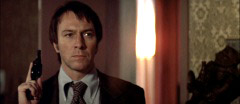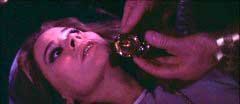 KATARINA’S
NIGHTMAE THEATER: THE PYX (1973)
KATARINA’S
NIGHTMAE THEATER: THE PYX (1973)Director: Harvey Hart
Scorpion Releasing
 KATARINA’S
NIGHTMAE THEATER: THE PYX (1973)
KATARINA’S
NIGHTMAE THEATER: THE PYX (1973)Karen Black has a date with THE PYX, an unsettling bit of Canuxploitation finally restored to its Panavision screen dimensions, courtesy of Scorpion Releasing as part of their “Katarina’s Nightmare Cinema” series.

Quebec police detective Henderson (Christopher Plummer, MURDER BY DECREE) and his partner Paquette (Donald Pilon, I MISS YOU, HUGS AND KISSES) are called to the scene of the suspicious death of a hooker named Elizabeth Lucy (Karen Black, BURNT OFFERING), who had jumped or was pushed off the balcony of an empty penthouse apartment. She was wearing a transparent gown, an inverted crucifix, and was clutching a pyx (a small brass box used for transporting the host to the sick or dying who cannot come to church to receive communion) in her hand. Elizabeth’s cold madam Meg (Yvette Brind’amour) and her shattered roommate Laura are unable or unwilling to tell them the identity of her last client, and Elizabeth’s only close friend was another hooker Sandra (Louise Rinfret) who mysteriously disappeared the week before. Henderson investigates the penthouse and finds a tape recording of Gregorian chanting. He overhears the uncooperative building super (Jacques Godin) telephoning a Mr. Lefram about the police investigation. Henderson learns that Lefram (Lee Broker, SCANNERS) is an ex-con in the employment of businessman Kearson (Jean Louis Roux, THE HOTEL NEW HAMPSHIRE). Meanwhile, flashbacks to Elizabeth’s life reveal her to be a non-practicing Catholic with a heroin problem who catches the eye of Kearson and is manipulated by Meg into taking the disappeared Sandra’s place to help him “achieve a miracle.”
 Audiences
attracted by Cinerama Releasing’s hard-sell advertising were probably
not expecting a slow-burn thriller. Based on the novel by John Buell, the film
is less about the murder investigation and Satanism than it is about Elizabeth’s
salvation (even Henderson never finds out the entire truth). The flashbacks
and Henderson’s interrogations reveal everything Elizabeth tried to do
to help others while relying on heroin for her own escape. Elizabeth was responsible
for Sandra’s disappearance, having placed her in a private hospital to
deal with her out-of-control heroin addiction. She also befriended and took
in an abused gay man named Jimmy (ILSA, THE TIGRESS OF SIBERA), who describes
her to Henderson as the only woman he has ever loved. Sensing that something
bad is going to happen to her, she tries to make sure they are taken care of
before attempting to flee the country. When she realizes that there is no escape,
she resigns herself to whatever Kearson intends for her (until she realizes
what Kearson wants her to do in order for him to achieve his “miracle”).
Audiences
attracted by Cinerama Releasing’s hard-sell advertising were probably
not expecting a slow-burn thriller. Based on the novel by John Buell, the film
is less about the murder investigation and Satanism than it is about Elizabeth’s
salvation (even Henderson never finds out the entire truth). The flashbacks
and Henderson’s interrogations reveal everything Elizabeth tried to do
to help others while relying on heroin for her own escape. Elizabeth was responsible
for Sandra’s disappearance, having placed her in a private hospital to
deal with her out-of-control heroin addiction. She also befriended and took
in an abused gay man named Jimmy (ILSA, THE TIGRESS OF SIBERA), who describes
her to Henderson as the only woman he has ever loved. Sensing that something
bad is going to happen to her, she tries to make sure they are taken care of
before attempting to flee the country. When she realizes that there is no escape,
she resigns herself to whatever Kearson intends for her (until she realizes
what Kearson wants her to do in order for him to achieve his “miracle”).

Karen Black is up to the emotional demands of the role, coming across as considerably more complex than the usual “hooker with a heart of gold” (and looks great doing it as she models several different looks for the camera). Plummer – in the native Canadian actor’s first Canadian film production – gives a more detached performance throughout, until the climax where his character’s reserve is shaken (Plummer is certainly capable of chewing the scenery, as in Peter Collinson’s ill-advised remake of THE SPIRAL STAIRCASE). Pilon does not have much to do as Henderson’s partner; however, Brind’amour is effective as the madam, not only conflicted over sacrificing her favorite girl to Kearson, but also appearing to genuinely care for Elizabeth. Broker isn’t sinister or intimidating enough as Kearson’s henchman, but his facial expressions during the black mass sequence reveal his character to be not as jaded as he appears elsewhere. Robin Gammel (RITUALS) appears as an observant neighbor of Meg and her girls.
 Director
Harvey Hart only directed a handful of theatrical features, including BUS RILEY’S
BACK IN TOWN and FORTUNE AND MEN’S EYES, but he had a prolific career
from the late 1950s until his death in 1989, directing TV movies (including
the 1981 miniseries of EAST OF EDEN and THE ALIENS ARE COMING) and episodes
of several popular series including SPENSER FOR HIRE, THE MOD SQUAD, MEDICAL
CENTER and COLUMBO. Producer Julian Roffman had helmed the Canadian 3D cult
item THE MASK more than a decade earlier and later produced the John Saxon action
flick THE GLOVE. The year before producing THE PYX, Maxine Samuels left her
talk show “All About Women” when the Canadian Broadcasting Corporation
(CBC) would not air an episode she had taped with Xaviera “The Happy Hooker”
Hollander. THE PYX was the only theatrical feature of screenwriter Robert Schlitt,
who seems to have been an ideal choice for the adaptation as most of his subsequent
writing assignments have been for cop and detective shows from THE STREETS OF
SAN FRANCISCO, ADAM-12, and HAWAII FIVE-O to MATLOCK, THE FATHER DOWLING MYSTERIES
and HILL STREET BLUES. Composer Harry Freedman scores the film with the usual
strings, but provides black mass scoring combining regular Gregorian chants
with another distorted set that has the pitch of Alvin and the Chipmunks yet
manages to be creepy. The score, however, is dominated by a pair of songs penned
and performed by actress Karen Black herself utilizing verses from “Song
of Solomon.” The low-key cinematography of Canadian stalwart Rene Verzier
(RABID) lenses the drab locations naturalistically while wringing plenty of
atmosphere out of the lighting and framing of the more ornate settings of various
churches, hospitals and Kearson’s penthouse.
Director
Harvey Hart only directed a handful of theatrical features, including BUS RILEY’S
BACK IN TOWN and FORTUNE AND MEN’S EYES, but he had a prolific career
from the late 1950s until his death in 1989, directing TV movies (including
the 1981 miniseries of EAST OF EDEN and THE ALIENS ARE COMING) and episodes
of several popular series including SPENSER FOR HIRE, THE MOD SQUAD, MEDICAL
CENTER and COLUMBO. Producer Julian Roffman had helmed the Canadian 3D cult
item THE MASK more than a decade earlier and later produced the John Saxon action
flick THE GLOVE. The year before producing THE PYX, Maxine Samuels left her
talk show “All About Women” when the Canadian Broadcasting Corporation
(CBC) would not air an episode she had taped with Xaviera “The Happy Hooker”
Hollander. THE PYX was the only theatrical feature of screenwriter Robert Schlitt,
who seems to have been an ideal choice for the adaptation as most of his subsequent
writing assignments have been for cop and detective shows from THE STREETS OF
SAN FRANCISCO, ADAM-12, and HAWAII FIVE-O to MATLOCK, THE FATHER DOWLING MYSTERIES
and HILL STREET BLUES. Composer Harry Freedman scores the film with the usual
strings, but provides black mass scoring combining regular Gregorian chants
with another distorted set that has the pitch of Alvin and the Chipmunks yet
manages to be creepy. The score, however, is dominated by a pair of songs penned
and performed by actress Karen Black herself utilizing verses from “Song
of Solomon.” The low-key cinematography of Canadian stalwart Rene Verzier
(RABID) lenses the drab locations naturalistically while wringing plenty of
atmosphere out of the lighting and framing of the more ornate settings of various
churches, hospitals and Kearson’s penthouse.

Long available only as a panned-and-scanned transfer on VHS from Prism Entertainment (likely the source of some terrible budget DVDs, including one under the alternate title THE HOOKER CULT MURDERS), THE PYX has finally been restored to its 2.35:1 scope dimensions in a new anamorphic HD transfer from the original negative by Scorpion Releasing. The first twenty minutes of the film are dark and grainy, but this is likely a result of conceptual choices made by the cinematographer since subsequent daylight scenes are clean and sharp. The color scheme is deliberately muted, which is borne out by the rare instances of saturated colors like the strikingly blue chairs in Elizabeth’s apartment and various shades of lavender (which almost seems to stain the black mass sequence). Only one of the reel changes is particularly rough, and there are rare instances of scratching. The mono audio has some faint hiss, but the dialogue and music come through clearly.
 The
disc’s major extra is an audio commentary with Karen Black, moderated
by Marc Edward Heuck. Black describes her technical approach to acting and makes
some interesting observations about the subtleties of Plummer’s performance.
She describes her research into heroin addiction, penning the songs for the
film, and the use of a body double for certain angles. She gets distracted by
various little onscreen details, but they usually spark memories of the shoot
or her career during this period. Riffing on her comments about the source of
the title song, Heuck describes the theme of “flight” from Toni
Morrison’s novel Song of Solomon and other works that reference
“Song of Solomon” and is able to relate them back to themes in the
film. Heuck’s research includes remarks made by Hart about the film in
an unidentified book on Canadian exploitation cinema (I imagine it must be Caelum
Vatnsdal’s They Came From Within: A History Of Canadian Horror Cinema)
as well as interpretations of some of the ambiguous religious imagery. Both
of the commentators note the film’s pacing and perceived shortcomings
(Black says that her character has no driving goal, and it does seem as though
the ending would have been more dramatic if the character had had some want
to relinquish when she realizes what she must do for the greater good). There
is a brief discussion of Canuxploitation of this period, although neither Black
nor Heuck mention the actress’ other later Canadian horror film: George
Mihalka’s astral projection thriller THE BLUE MAN, which was released
in the U.S. under the title ETERNAL EVIL.
The
disc’s major extra is an audio commentary with Karen Black, moderated
by Marc Edward Heuck. Black describes her technical approach to acting and makes
some interesting observations about the subtleties of Plummer’s performance.
She describes her research into heroin addiction, penning the songs for the
film, and the use of a body double for certain angles. She gets distracted by
various little onscreen details, but they usually spark memories of the shoot
or her career during this period. Riffing on her comments about the source of
the title song, Heuck describes the theme of “flight” from Toni
Morrison’s novel Song of Solomon and other works that reference
“Song of Solomon” and is able to relate them back to themes in the
film. Heuck’s research includes remarks made by Hart about the film in
an unidentified book on Canadian exploitation cinema (I imagine it must be Caelum
Vatnsdal’s They Came From Within: A History Of Canadian Horror Cinema)
as well as interpretations of some of the ambiguous religious imagery. Both
of the commentators note the film’s pacing and perceived shortcomings
(Black says that her character has no driving goal, and it does seem as though
the ending would have been more dramatic if the character had had some want
to relinquish when she realizes what she must do for the greater good). There
is a brief discussion of Canuxploitation of this period, although neither Black
nor Heuck mention the actress’ other later Canadian horror film: George
Mihalka’s astral projection thriller THE BLUE MAN, which was released
in the U.S. under the title ETERNAL EVIL.
 The
main menu lists a trailer, but it is actually two cropped TV spots (one 60-second
and one 30-second). The film is playable with optional opening and closing sequences
featuring hostess Katarina Leigh Waters, here as “Just Another Dead Hooker,”
briefly introducing the film, actors, and defining what a “pyx”
is for the audience long (long) before the film decides to do so. Her contribution
here is rather slight compared to FINAL EXAM, in which she also moderated the
commentary track. Trailers for THE HOUSE ON SORORITY ROW (coming from Scorpion
in a two-disc special edition), HUMONGOUS, NOTHING BUT THE NIGHT, HUMAN EXPERIMENTS,
INCUBUS and THE DEVIL WITHIN HER (I DON’T WANT TO BE BORN) round out the
extras (although Katarina’s closing remarks segment includes a clip reel
which features snippets of a handful of other upcoming releases).
(Eric
Cotenas)
The
main menu lists a trailer, but it is actually two cropped TV spots (one 60-second
and one 30-second). The film is playable with optional opening and closing sequences
featuring hostess Katarina Leigh Waters, here as “Just Another Dead Hooker,”
briefly introducing the film, actors, and defining what a “pyx”
is for the audience long (long) before the film decides to do so. Her contribution
here is rather slight compared to FINAL EXAM, in which she also moderated the
commentary track. Trailers for THE HOUSE ON SORORITY ROW (coming from Scorpion
in a two-disc special edition), HUMONGOUS, NOTHING BUT THE NIGHT, HUMAN EXPERIMENTS,
INCUBUS and THE DEVIL WITHIN HER (I DON’T WANT TO BE BORN) round out the
extras (although Katarina’s closing remarks segment includes a clip reel
which features snippets of a handful of other upcoming releases).
(Eric
Cotenas)